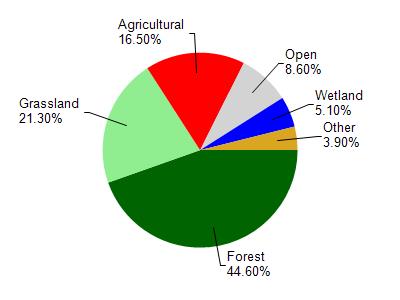La Crosse
Yes
Yes
No
Fish and Aquatic Life
Overview
Berge Coulee Creek, also known as Bergen Coulee and Creek 35-16, is located in southeastern La Crosse County, northeast of Coon Valley. It flows in a southerly direction for approximately 1.5 miles before reaching Timber Coulee Creek. It has a steep gradient of 77 feet per mile and drains forested hillsides, lowland pasture and agricultural land. Berge Coulee Creek is a Class I trout stream for its entire length.
From: Koperski, Cindy. 2002. The State of the Bad Axe - La Crosse Basin. Wisconsin Department of Natural Resources, Madison, WI
Date 2011
Author Cynthia Koperski
Historical Description
A survey conducted in 1975 documented clear, cool water that carried a low suspended silt load. The streambed consisted of rubble, gravel, sand, silt and abundant aquatic vegetation. Pasture comprised the majority of bank cover, with some swamp hardwood and shrub marsh also. In-stream cover was common and consisted of undercut banks, rocks, boulders, logs and trees. A few deep holes were present in the lower section of the stream with good underwater cover. A 1983 fishery survey documented a naturally reproducing population of brown trout. There are no WDNR stocking records for Berge Coulee Creek. Access is available from three road crossings and WDNR streambank easements.
From: Koperski, Cindy. 2002. The State of the Bad Axe - La Crosse Basin. Wisconsin Department of Natural Resources, Madison, WI
Date 2011
Author Cynthia Koperski
General Condition
Water chemistry testing of streams throughout La Crosse County was initiated by the La Crosse County Land Conservation Department in 1998. Baseflow conditions were targeted for testing as the most likely to show normal water quality conditions. Sampling takes place four times annually when no rainfall or snowmelt has occurred during the previous 72 hours. Of the samples taken between 1998 and 2001, Berge Coulee Creek met the county phosphorus goal in 100% of the samples taken. The county fecal coliform bacteria goal was met in 80% of the samples taken. These data point to high water quality conditions in Berge Coulee Creek. La Crosse County should continue baseflow sampling of Berge Coulee Creek to determine water quality trends. Macroinvertebrate IBI data were collected in 1990 and 1989 at Creek 35-16 (Berge Coulee) Station 1 - Cth X Bridge Near Cth P, the average of which is considered good condition (5.2).
Date 2011
Author Lisa Helmuth
Condition
Wisconsin has over 84,000 miles of streams, 15,000 lakes and milllions of acres of wetlands. Assessing the condition of this vast amount of water is challenging. The state's water monitoring program uses a media-based, cross-program approach to analyze water condition. An updated monitoring strategy (2015-2020) is now available. Compliance with Clean Water Act fishable, swimmable standards are located in the Executive Summary of Water Condition in 2018. See also the 'monitoring and projects' tab.
Reports
Management Goals
Wisconsin's Water Quality Standards provide qualitative and quantitative goals for waters that are protective of Fishable, Swimmable conditions [Learn more]. Waters that do not meet water quality standards are considered impaired and restoration actions are planned and carried out until the water is once again fishable and swimmable
Management goals can include creation or implementation of a Total Maximum Daily Load analysis, a Nine Key Element Plan, or other restoration work, education and outreach and more. If specific recommendations exist for this water, they will be displayed below online.
Monitoring
Monitoring the condition of a river, stream, or lake includes gathering physical, chemical, biological, and habitat data. Comprehensive studies often gather all these parameters in great detail, while lighter assessment events will involve sampling physical, chemical and biological data such as macroinvertebrates. Aquatic macroinvertebrates and fish communities integrate watershed or catchment condition, providing great insight into overall ecosystem health. Chemical and habitat parameters tell researchers more about human induced problems including contaminated runoff, point source dischargers, or habitat issues that foster or limit the potential of aquatic communities to thrive in a given area. Wisconsin's Water Monitoring Strategy was recenty updated.
Grants and Management Projects
| Project Name (Click for Details) | Year Started |
|---|
|
|
Monitoring Projects
| WBIC | Official Waterbody Name | Station ID | Station Name | Earliest Fieldwork Date | Latest Fieldwork Date | View Station | View Data |
|---|
| 1646400 | Berge Coulee Creek | 10013775 | Creek 35-16 (Berge Coulee) Station 1 - Cth X Bridge Near Cth P | 11/4/1989 | 10/8/2025 | Map | Data |
| 1646400 | Berge Coulee Creek | 10014129 | Creek 35-16(Berge Coulee Creek)Station 2- 1975-Nw 1/4 Sw 1/4 S36 | | | Map | Data |
| 1646400 | Berge Coulee Creek | 10013776 | Creek 35-16 (Berge Coulee) Station 2 - Field Road Crossing In Sw 1/4 Nw 1/4 | | | Map | Data |
|

Watershed Characteristics
Berge Coulee Creek is located in the Coon Creek watershed which is 238.20 mi². Land use in the watershed is primarily forest (44.60%), grassland (21.30%) and a mix of agricultural (16.50%) and other uses (17.60%). This watershed has 574.90 stream miles, 4,342.05 lake acres and 6,052.31 wetland acres.
Nonpoint Source Characteristics
This watershed is ranked High for runoff impacts on streams, Not Ranked for runoff impacts on lakes and Medium for runoff impacts on groundwater and therefore has an overall rank of Medium. This value can be used in ranking the watershed or individual waterbodies for grant funding under state and county programs.However, all waters are affected by diffuse pollutant sources regardless of initial water quality. Applications for specific runoff projects under state or county grant programs may be pursued. For more information, go to surface water program grants.